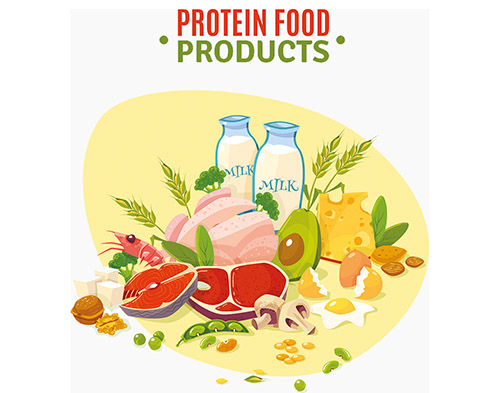
In today’s world, where discretion is an afterthought through the lens of social media, consumers are giving viewers their all. People want to look their best, no filter included. Some post their post-gym sweat sessions, while others just stand in front of the mirror, displaying their muscled trophies to the world. Though it may seem easy to attain those chiseled prizes, they are actually respectably earned. Muscle is built on a foundation composed of exercise and nutrition. Though building muscle may come easier to some, it’s actually achievable by all with the right mindset, appropriate exercise regimen and adequate protein intake.
The current recommended dietary allowance (RDA)for protein is about 0.8 grams(gm)/kilogram(kg) of your body weight. The range of calories that should stem from protein sources should be about 10-35% of total calories consumed. Below is a list of proteins and the amount of protein you get from ingesting them:
- Beef tenderloin steak, lean only (3.5 oz): 29 g
- Salmon (4 oz): 29 g
- Lentils (1 cup): 18 g
- Greek yogurt (5 oz): 14 g
- Chicken (3 oz):23 gm
- Skim milk (8 oz): 8 g
- Tofu, firm (3.5 oz): 7 g
- Egg, large (1 large): 6 g
Protein is made up of amino acids, the building blocks for cells and tissues. There are twenty amino acids in total that combine together to form different types of proteins. Nine amino acids (histidine, isoleucine, leucine, lysine, methionine, phenylalanine, threonine, tryptophan, and valine) are essential, which means that the body can’t synthesize them on its own and must ingest them through diet. Animal sources may be a better way to consume your proteins than plant-based proteins, as they may be more bioavailable and consist of better-quality protein. They usually contain all nine essential amino acids as well, as opposed to plant-based ones. However, if plant-based proteins are more appealing for any reason, one can meet protein needs by combining different foods. Some examples of attaining all nine essential amino acids are by consuming rice and beans, hummus and pita bread or peanut butter and whole wheat bread, just to name a few.
The body uses amino acids for muscle protein synthesis (MPS), the impetus behind muscle repair, recovery, and growth after strenuous exercise. If people don’t consume enough protein, their body tends to break down muscle to provide enough energy to support necessary body functions and preserve tissue. In order to build muscle, you must consume more protein that you break down. This is called a positive nitrogen balance, as all proteins are derived from nitrogen.
How much protein doesone need to get that chiseled look that is desired by many? That number is disputed, with research that provides evidence for many different numbers. One meta-analysis (a collection of research studies reviewed) published in 2020 in Nutrition Review found that protein intakes ranging from 0.5-3.5 gm/kg can support increases in lean body mass (LBM). Another meta-analysis from 2022 published in Sports Medicine states that an intake of about 1.5 gm/kg of body weight paired with resistance training are required for optimal effects of muscle strength. An increase in protein intake didn’t appear to support a concurrent increase in muscle mass or strength.
From all studies that have been reviewed regarding this topic, it seems as if the collective opinion of optimal protein intake for muscle building is between 1.2-1.6 gm/kg of body weight. For example, if a 158 lb male is looking to increase his protein intake and add some muscle to his metabolic repertoire, he should eat somewhere between 86-108 gm/kg of protein. In summary, a combination of hitting the gym and boosting your protein intake will help attain your dream goal for those wanting to look their best, no filter included.
Melissa Papir is a registered dietitian working in long-term care nutrition in Washington Heights, New York. She works with middle-aged to elderly residents to provide nutrition that can help boost their quality of life. She loves to write about nutrition in her spare time. She can be reached at mpapir@forttryonrehab.com.










